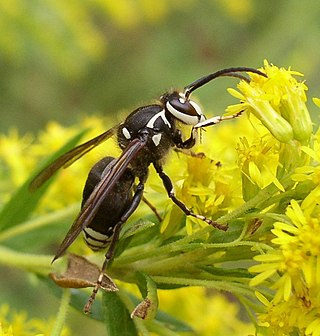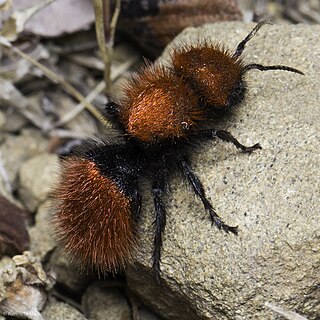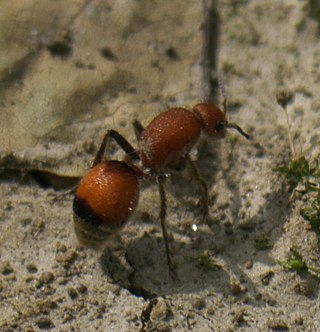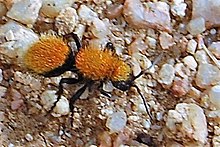
In evolutionary biology, mimicry is an evolved resemblance between an organism and another object, often an organism of another species. Mimicry may evolve between different species, or between individuals of the same species. In the simplest case, as in Batesian mimicry, a mimic resembles a model, so as to deceive a dupe, all three being of different species. A Batesian mimic, such as a hoverfly, is harmless, while its model, such as a wasp, is harmful, and is avoided by the dupe, such as an insect-eating bird. Birds hunt by sight, so the mimicry in that case is visual, but in other cases mimicry may make use of any of the senses. Most types of mimicry, including Batesian, are deceptive, as the mimics are not harmful, but Müllerian mimicry, where different harmful species resemble each other, is honest, as when species of wasps and of bees all have genuinely aposematic warning coloration. More complex types may be bipolar, involving only two species, such as when the model and the dupe are the same; this occurs for example in aggressive mimicry, where a predator in wolf-in-sheep's-clothing style resembles its prey, allowing it to hunt undetected. Mimicry is not limited to animals; in Pouyannian mimicry, an orchid flower is the mimic, resembling a female bee, its model; the dupe is the male bee of the same species, which tries to copulate with the flower, enabling it to transfer pollen, so the mimicry is again bipolar. In automimicry, another bipolar system, model and mimic are the same, as when blue lycaenid butterflies have 'tails' or eyespots on their wings that mimic their own heads, misdirecting predator dupes to strike harmlessly. Many other types of mimicry exist.

Apocrita is a suborder of insects in the order Hymenoptera. It includes wasps, bees, and ants, and consists of many families. It contains the most advanced hymenopterans and is distinguished from Symphyta by the narrow "waist" (petiole) formed between the first two segments of the actual abdomen; the first abdominal segment is fused to the thorax, and is called the propodeum. Therefore, it is general practice, when discussing the body of an apocritan in a technical sense, to refer to the mesosoma and metasoma rather than the "thorax" and "abdomen", respectively. The evolution of a constricted waist was an important adaption for the parasitoid lifestyle of the ancestral apocritan, allowing more maneuverability of the female's ovipositor. The ovipositor either extends freely or is retracted, and may be developed into a stinger for both defense and paralyzing prey. Larvae are legless and blind, and either feed inside a host or in a nest cell provisioned by their mothers.

A tarantula hawk is a spider wasp (Pompilidae) that preys on tarantulas. Tarantula hawks belong to any of the many species in the genera Pepsis and Hemipepsis. They are one of the largest parasitoid wasps, using their sting to paralyze their prey before dragging it to a brood nest as living food; a single egg is laid on the prey, hatching to a larva which eats the still-living host. They are found on all continents other than Europe and Antarctica.

Wasps in the family Pompilidae are commonly called spider wasps, spider-hunting wasps, or pompilid wasps. The family is cosmopolitan, with some 5,000 species in six subfamilies. Nearly all species are solitary, and most capture and paralyze prey, though members of the subfamily Ceropalinae are kleptoparasites of other pompilids, or ectoparasitoids of living spiders.

Batesian mimicry is a form of mimicry where a harmless species has evolved to imitate the warning signals of a harmful species directed at a predator of them both. It is named after the English naturalist Henry Walter Bates, who worked on butterflies in the rainforests of Brazil.

Vespoidea is a superfamily of wasps in the order Hymenoptera. Vespoidea includes wasps with a large variety of lifestyles including eusocial, social, and solitary habits, predators, scavengers, parasitoids, and some herbivores.

Anti-predator adaptations are mechanisms developed through evolution that assist prey organisms in their constant struggle against predators. Throughout the animal kingdom, adaptations have evolved for every stage of this struggle, namely by avoiding detection, warding off attack, fighting back, or escaping when caught.

The Schmidt sting pain index is a pain scale rating the relative pain caused by different hymenopteran stings. It is mainly the work of Justin O. Schmidt, who was an entomologist at the Carl Hayden Bee Research Center in Arizona. Schmidt published a number of works on the subject and claimed to have been stung by the majority of stinging Hymenoptera.

Müllerian mimicry is a natural phenomenon in which two or more well-defended species, often foul-tasting and sharing common predators, have come to mimic each other's honest warning signals, to their mutual benefit. The benefit to Müllerian mimics is that predators only need one unpleasant encounter with one member of a set of Müllerian mimics, and thereafter avoid all similar coloration, whether or not it belongs to the same species as the initial encounter. It is named after the German naturalist Fritz Müller, who first proposed the concept in 1878, supporting his theory with the first mathematical model of frequency-dependent selection, one of the first such models anywhere in biology.

Aposematism is the advertising by an animal, whether terrestrial or marine, to potential predators that it is not worth attacking or eating. This unprofitability may consist of any defenses which make the prey difficult to kill and eat, such as toxicity, venom, foul taste or smell, sharp spines, or aggressive nature. These advertising signals may take the form of conspicuous coloration, sounds, odours, or other perceivable characteristics. Aposematic signals are beneficial for both predator and prey, since both avoid potential harm.

Dasymutilla is a wasp genus belonging to the family Mutillidae. Their larvae are external parasites to various types of ground-nesting Hymenoptera. Members of this genus are highly variable in sting intensity, ranging from a 1 (D. thetis) to a 3 in the Schmidt sting pain index.

Dasymutilla gloriosa, sometimes referred to as the thistledown velvet ant, is a member of the genus Dasymutilla. Only females are wingless, as in other mutillids. Compared to other mutillids, it is mid-sized, being larger than some of the smallest known species like Dasymutilla vesta but smaller than some of the largest known species like Dasymutilla klugii. It ranges from Utah, Nevada, California, Arizona, New Mexico, Texas and south into Mexico.

A wasp is any insect of the narrow-waisted suborder Apocrita of the order Hymenoptera which is neither a bee nor an ant; this excludes the broad-waisted sawflies (Symphyta), which look somewhat like wasps, but are in a separate suborder. The wasps do not constitute a clade, a complete natural group with a single ancestor, as bees and ants are deeply nested within the wasps, having evolved from wasp ancestors. Wasps that are members of the clade Aculeata can sting their prey.

Dasymutilla occidentalis is a species of parasitoid wasp that ranges from Connecticut to Kansas in the north and Florida to Texas in the south. Adults are mostly seen in the summer months.

Mutilla europaea, the large velvet ant, is a species of parasitoid wasps belonging to the family Mutillidae. It is a parasitoid on various species of bumblebees and is found in Europe, Asia, and North Africa.

Hemipepsis ustulata is a species of tarantula hawk wasp native to the Southwestern United States. Tarantula hawks are a large, conspicuous family of long-legged wasps that prey on tarantulas by using their long legs to grapple with their prey and then paralyze them with a powerful sting. They are solitary, displaying lekking territorial behavior in their mating rituals.

Pepsis grossa is a very large species of pepsine spider wasp from the southern part of North America, south to northern South America. It preys on tarantula spiders, giving rise to the name tarantula hawk for the wasps in the genus Pepsis and the related Hemipepsis. Only the females hunt, so only they are capable of delivering a sting, which is considered the second most painful of any insect sting; scoring 4.0 on the Schmidt sting pain index compared to the bullet ant's 4.0+. It is the state insect of New Mexico. The colour morphs are the xanthic orange-winged form and the melanic black winged form. In northern South America, a third form, known as "lygamorphic", has a dark base to the wings which have dark amber median patches and a pale tip.

The Myrmosidae are a small family of wasps very similar to the Mutillidae. As in mutillids, females are flightless, and are kleptoparasites in the nests of fossorial bees and wasps.

Euspinolia militaris is a species of wasp in the family Mutillidae. Though it is a wingless wasp, it has sometimes been referred to by the name panda ant.

Pompiloidea is a superfamily that includes spider wasps and velvet ants, among others, in the order Hymenoptera. There are 4 families in Pompiloidea.






















